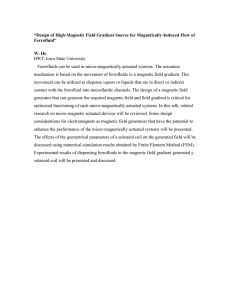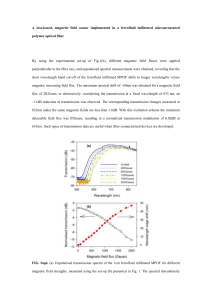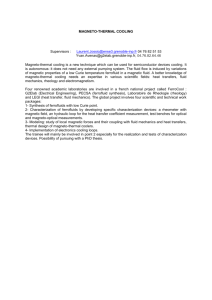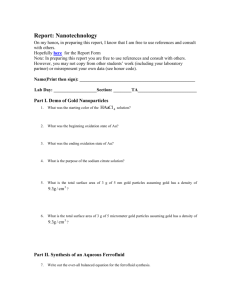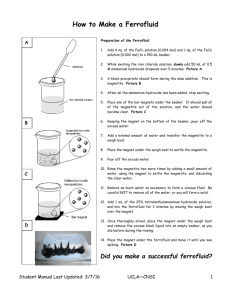Ferrofluid Drops Studying Ferrofluids with High Speed Video
advertisement
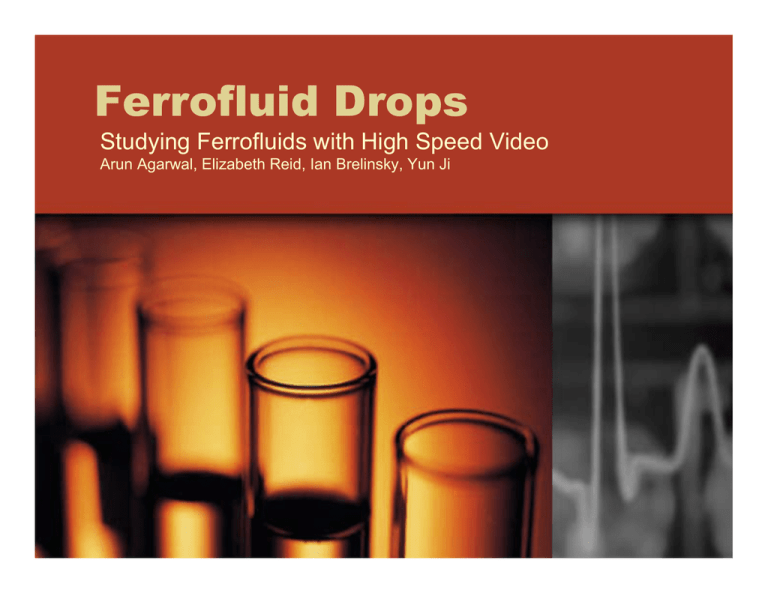
Ferrofluid Drops Studying Ferrofluids with High Speed Video Arun Agarwal, Elizabeth Reid, Ian Brelinsky, Yun Ji Today’s Agenda Background - Ferrofluids & Magnets - Goals of the Experiment Qualitative Results - Procedure - Observations of Fluid Behavior - Ways to Improve Quantitative Results - Procedure - Analysis of Drop Data - Ways to Improve Future Work - Future work on ferrofluids Background - Ferrofluids • Unique class of liquids that are magnetic • Composed of nanoscale magnetic particles suspended in a carrier fluid • Ferrofluid we used was EPH1 – Hydrocarbon based – Non-toxic – Stains clothes and some lab equipment! Background - Ferrofluids B Picture taken with Nikon D100 digital camera. Aperture: 3.5, Focal Length: 24mm, Exposure Time: .0016s Background - Magnets • For qualitative results, used a number of magnets to create maximum normal field • For quantitative results, used Neodymium Iron Boride (NdFeB) magnet Field at surface = .45T Assuming point charge: 0.6 cm 1.2 cm Field = M * 1/ r^2 .45 = M * 1/(.006)^2 Field = 1.62E-5/r^2 This will not be perfect as we are working in near field Background – Our Goals • Determine what interesting properties HSV or other imaging techniques can show us about ferrofluid drops • Make a series of qualitative observations about ferrofluid drops in magnetic fields • Identify and study quantifiable features in more depth Qualitative - Procedure • Observed how ferrofluid’s splash was affected by a magnet • Tested with and without magnet: – Ferrofluid into Soy Milk – Soy Milk into Ferrofluid – Ferrofluid into Ferrofluid – Ferrofluid onto Glass Qualitative – Setup Red numbers indicate distances while blue numbers indicate heights. Picture taken with Nikon D100 digital camera. Aperture: 3.5, Focal Length: 24mm, Exposure Time: .0016s Qualitative – HSV Settings • • • • • • Resolution: 1024x1024 Sample Rate: 1000 pps Exposure: 100 microseconds Post trigger: 1 pixel Duration: 1 second Lens: 200mm with aperture f/5.6 Qualitative – Observations • Magnetic Fields on Ferrofluids lead to: – Elongation of drop – Skewing of drop toward magnet – Increased impact force – Change in crown behavior Qualitative – Observations Qualitative – Observations Magnet No Magnet Qualitative – Observations Qualitative – Observations Better Images • Use a dish with lower edges – Some edges are necessary! • Need less blur and more depth of field – Will require more and cooler lights • Other techniques were not options: – Sync-&-Delay Trigger Broken – Color HSV would require too much light Quantitative – Procedure • Measured how velocity of ferrofluid increased in the presence of a known magnet field – Compared against water drops • Measured horizontal distance at which ferrofluid is unaffected by a magnetic field (quantitative analysis pending). Quantitative – Setup Red numbers indicate distances while blue numbers indicate heights. Picture taken with Nikon D100 digital camera. Aperture: 3.5, Focal Length: 24mm, Exposure Time: .0016s Quantitative – HSV Settings • • • • • • Resolution: 1024x1024 Sample Rate: 1000 pps Exposure: 100 microseconds Post trigger: 1 pixel Duration: 1 second Lens: 105mm with aperture f/4 Quantitative – Measurements Top Point Left Point Right Point Bottom Point Quantitative – Velocity of Ferrofluid vs. Water 4.50 4.00 3.50 Average change in ferrofluid velocity over 3 ms: 1.244 m/s 2.50 2.00 1.50 1.00 0.50 5 te r wa te r wa wa 4 3 te r 2 te r wa wa te r 1 5 fe rr o 4 fe rr o 3 rr o fe rr o fe rr o 1 2 0.00 fe Velocity (m/s) 3.00 Trial y1 y2 y3 y4 Quantitative – Ferrofluid Drops (contd.) • Acceleration due to gravity was negligible due to short (5 millisecond) time frame • Velocity of water dropping over same time period remained the same • Average acceleration for ferrofluid drops was approximately 414 m/s2 • Ferrofluid’s magnetic dipoles align almost instantaneously with external magnetic force • Magnetic field strength is inversely proportional to square of distance Quantitative – Velocity of Ferrofluid and Magnetic Field Strength 4.500 4.000 3.500 Velocity (m/s) 3.000 2.500 2.000 1.500 1.000 0.500 0.000 0.000 0.020 0.040 0.060 0.080 0.100 0.120 0.140 0.160 0.180 0.200 Magnet Field Strength (T/cm^2) • Ferrofluid drop velocity correlates with applied magnetic field strength Quantitative – Skew Studies Quantitative – Improving Results • Control drop size better • Capture at a higher frame rate (5 frames provides limited data) • Use a more ideal magnetic field • Improve pictures (as already discussed) Future Work on Ferrofluids • Try using an electromagnet – Exact control on field strength – Ability to vary field strength – Suspending drop in mid air. • Spiky or spherical? • Horizontal uniform magnetic field • Drop multiple drops simultaneously Strobe has been fun! Thank you Dr. Bales, Christina, and classmates!
